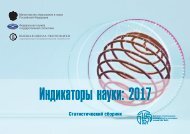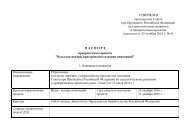REUTERS/CARLOS
Samie_vliyatelnie_uchenie_2015
Samie_vliyatelnie_uchenie_2015
Create successful ePaper yourself
Turn your PDF publications into a flip-book with our unique Google optimized e-Paper software.
INTRODUCTION<br />
Who are some of the best<br />
and brightest scientific minds<br />
of our time?<br />
Thomson Reuters answers this question, as it<br />
has in the past, by analyzing data from its Web of<br />
Science and InCites platforms to determine which<br />
researchers have produced published works that<br />
are most cited by their peers.<br />
The some 3,000 highly cited researchers listed<br />
in this report were selected by analyzing citation<br />
data over a recent 11-year period (2003-2013)<br />
and identifying those who published the greatest<br />
number of highly cited papers. We also identified<br />
hot researchers, authors of papers published<br />
in a recent two-year period (2013-2014) that<br />
were cited immediately after publication at<br />
extraordinarily high levels. Highly cited papers<br />
rank in the top 1% and hot papers rank in the top<br />
.1% of the citation distributions of comparable<br />
papers, those matched for field and age.<br />
Both hot papers and highly cited papers are<br />
featured in the Essential Science Indicators<br />
database of Thomson Reuters, presented within<br />
the InCites platform.<br />
It is precisely this type of recognition—by peers<br />
in the form of citations given—that makes highly<br />
cited or hot researcher status meaningful. The<br />
identification of these individuals is rooted in<br />
the collective, objective opinions of field experts<br />
within the scientific community.<br />
For time to time certain arguments appear,<br />
sometimes voiced by scientists themselves, on<br />
the negative or corrosive effects in the research<br />
community of drawing attention to specific<br />
persons through awards or special designations<br />
such as being a highly cited or hot researcher.<br />
Such social conventions, however, reflect a reality<br />
that is indisputable: human talent is unequally<br />
distributed in research just as in the arts or<br />
athletics. In fact, Diana Hicks and J. Sylvan Katz,<br />
science policy analysts and scientometricians,<br />
have argued that lack of recognition and relative<br />
underfunding of elite scientists likely result in<br />
“the suppression of incentives for the very best<br />
scientists.” They add: “The consequences for the<br />
performance of a national research system may<br />
be substantial” (D. Hicks, J.S. Katz, “Equity and<br />
Excellence in Research Funding,” Minerva, 49 (2):<br />
137-151, June 2011). Also, it should be understood<br />
that elite status is continually changing as<br />
researchers rise and fall in their influence<br />
throughout the years. Monitoring such changes,<br />
even annually, has an interest all its own.<br />
Everyone acknowledged in this book is a person<br />
of influence in the sciences and social sciences.<br />
They are often the researchers now on the cutting<br />
edge of their specialties. They are performing<br />
and publishing work that their peers recognize<br />
as central to the advancement of their science.<br />
These researchers are, thus, among the most<br />
influential scientific minds of our time.<br />
4 HIGHLY CITED RESEARCH DIRECTORY





